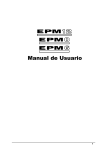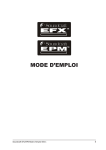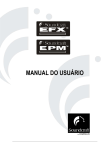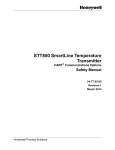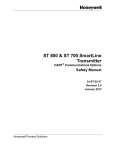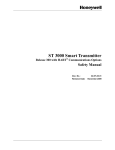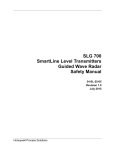Download Emerson Fisher 4660 Instruction Manual
Transcript
Instruction Manual Supplement D103776X012 4660 Pressure Pilot August 2013 Safety manual for Fisher® 4660 HighLow Pressure Pilot for Safety Instrumented System (SIS) Solutions When the Fisher 4660 highlow pressure pilot is used in a Safety Instrumented System (SIS) the design process should follow a safety lifecycle as described in several international standards (IEC61508, ANSI/ISA 84.01, etc.) The following must be thoroughly reviewed and implemented as part of the safety lifecycle. This is in addition to regular installation procedures and warnings listed in the latest version of the Fisher 4660 highlow pressure pilot instruction manual (D200163X012). WARNING This instruction manual supplement is not intended to be used as a stand-alone document. It must be used in conjunction with the following manual: Fisher 4660 HighLow Pressure Pilot Instruction Manual (D200163X012). Failure to use this instruction manual supplement in conjunction with above referenced manual could result in personal injury or property damage. If you have any questions regarding these instructions or need assistance in obtaining this document, contact your Emerson Process Management sale office. A. Definitions, Acronyms and Abbreviations 1. FIT Failure In Time (1x109 failures per hour) 2. FMEDA Failure Modes, Effects, and Diagnostics Analysis 3. Low Demand Mode Mode, where the demand interval for operation mode on a safetyrelated system is greater than twice the proof test interval. 4. PFDAVG average Probability of Failure on Demand 5. SIF Safety Instrumented Function 6. SIL Safety Integrity Level 7. SIS Safety Instrumented System B. Related Literature 1. D200163X012 Fisher 4660 HighLow Pressure Pilot (Instruction Manual) 2. Exida FMEDA Report for Fisher 4660 HighLow Pressure Pilot Report no. EPM 12/06089 R001 C. Product/ System Properties 1. The product is a highlow pressure pilot that activates emergency shutdown systems. It can be used with either a single or dual set point capability to maintain full output pressure when the process is operating within the set point range. www.Fisher.com Instruction Manual Supplement 4660 Pressure Pilot D103776X012 August 2013 2. The fail safe state for the 4660 pressure pilot is with zero output pressure. 3. The 4660 pressure pilot is a Type A device having a hardware fault tolerance of 0 (HFT = 0). The 4660 pressure pilot is limited to a Low Demand Mode of the SIS applications. 4. The 4660 pressure pilot is suitable for use in application to a maximum Safety Integrity Level of 3 (SIL3). 5. The failure rates for the 4660 pressure pilot are listed below. Consult the exida FMEDA report no. EPM12/06089 R001, available from your Emerson Process Management sales office, for a detailed list of the assumptions used in the analysis. Failure Rate (FIT) Configurations Failure Category Fail Safe Detected Fail Safe Undetected Fail Dangerous Detected Low Trip High Trip 0 0 High-Low Trip 0 307 278 290 0 0 0 Fail Dangerous Undetected 115 143 139 No Effect 482 482 502 6. A decrease in process pressure below the Low Set Point, or an increase in process pressure above the High Set Point trips the 4660 pressure pilot, i.e. vent the output pressure to zero. 7. When the process pressure returns to a value between the Low Set Point and the High Set Point, the 4660 pressure pilot resets to full output pressure. However, full output is not instantaneous. The difference between the set point and reset to full output is the triptoreset zone. 8. Safety Instrumented Function (SIF) design verification must be done for all components in the SIF including the 4660 highlow pressure pilot. The SIF must fulfill the requirements according to the Safety Integrity Level (SIL). Each subsystem must be checked to assure compliance with minimum hardware fault tolerance (HFT) requirements. 9. When using a 4660 pressure pilot in a redundant configuration, a common cause factor of at least 5% should be included in safety integrity calculations. D. Installation/ Configuration/ Commissioning 1. The 4660 pressure pilot complies with the requirements of ATEX Group II Category 2 Gas and Dust. 2. The ambient temperature limit is 59 to 71_C (75 to 160_F). 3. The supply pressure will be maintained within 1.4 to 4.5 bar (20 to 65 psig); too low supply pressure may not be sufficient to energize the pressure pilot properly. The supply medium must be clean, dry air that meets the requirements of ISA 7.0.01. A maximum 40 micrometer particle size in the air system is acceptable. 4. Normal installation is with the 4660 pressure pilot mounted vertically and with process, supply and output connections facing downward per 4660 instruction manual. 5. Preliminary to the high or low set point adjustment, make sure the bourdon tube contains no pressure, install either a pressure gauge or an optional indicator in the output pressure line, remove the cover screws and the cover, unlock the lock disk, turn the High Set knob clockwise and/or the Low Set knob counterclockwise until it has reached the travel end, and turn on supply pressure. 6. Connect an external pressure source to the process pressure connection. Adjust to the desired high or low set point pressure and turn the high or low knob. The high or low set point is obtained when the output pressure of the 4660 pressure pilot has changed from full output to zero. Lock the locking disk. 7. The safety function of the SIF must be tested after installation. E. Operations, Maintenance and Decommissioning 1. Personnel operating the 4660 pressure pilot and performing maintenance must be competent to do so. 2. Use lockout procedures and select the appropriate maintenance procedures as defined in instruction manual. The blockandbleed relay assembly and some other assemblies are offered as repair kits. 2 Instruction Manual Supplement D103776X012 4660 Pressure Pilot August 2013 3. A conservative approach is taken in estimating the service interval for the 4660 pressure pilot in Safety Instrumented Systems. For SIS applications, preventive maintenance must be performed on the 4660 pressure pilot at ten year intervals from the date of shipment. If the instrument is exposed to the upper or lower extremes of the environmental limits, the interval for the preventative maintenance may need to be reduced. 4. If air leakage is detected when the output signal is at full supply pressure or if the 4660 pressure pilot fails to trip properly, take corrective action by replacing the blockandbleed relay or the 4660 pressure pilot. To ensure continuous improvement and accurate reliability prediction, the user must also work with their local Emerson Process Management service representative to see that all failures are reported. F. Periodic Inspection, Test and Repair Periodic proof testing is an effective way to reduce the PFDavg of the 4660 pressure pilot as well as the valve and actuator it is connected to. Results of periodic inspections and tests should be recorded and reviewed. WARNING To avoid personal injury or property damage appropriate measures must be taken to ensure the safety of the process any time the SIF needs to be disabled, such as to perform a proof test or to take corrective actions. 1. Bypass the safety function and take appropriate action to avoid a false trip. 2. Interrupt or change the process signal to the 4660 pressure pilot to force the 4660 pressure pilot to the failsafe state and confirm that the safe state was achieved and within the correct time and that the trip occurred at the proper high or low set point(s). 3. Restore the process signal to the 4660 pressure pilot and inspect the 4660 pressure pilot for any leaks, visible damage or contamination and confirm that the normal operating state was achieved. 4. Remove the bypass and otherwise restore normal operation. 5. Repair consists of replacing the blockandbleed relay assembly and/or any other subassemblies and/or a whole 4660 pressure pilot as necessary. Note To ensure corrective action, continuous improvement, and accurate reliability prediction, the user must also work with their local Emerson Process Management service representative to see that all failures are reported. 3 4660 Pressure Pilot August 2013 Instruction Manual Supplement D103776X012 Neither Emerson, Emerson Process Management, nor any of their affiliated entities assumes responsibility for the selection, use or maintenance of any product. Responsibility for proper selection, use, and maintenance of any product remains solely with the purchaser and end user. Fisher is a mark owned by one of the companies in the Emerson Process Management business unit of Emerson Electric Co. Emerson Process Management, Emerson, and the Emerson logo are trademarks and service marks of Emerson Electric Co. All other marks are the property of their respective owners. The contents of this publication are presented for informational purposes only, and while every effort has been made to ensure their accuracy, they are not to be construed as warranties or guarantees, express or implied, regarding the products or services described herein or their use or applicability. All sales are governed by our terms and conditions, which are available upon request. We reserve the right to modify or improve the designs or specifications of such products at any time without notice. Emerson Process Management Marshalltown, Iowa 50158 USA Sorocaba, 18087 Brazil Chatham, Kent ME4 4QZ UK Dubai, United Arab Emirates Singapore 128461 Singapore www.Fisher.com 4E 2013 Fisher Controls International LLC. All rights reserved.





